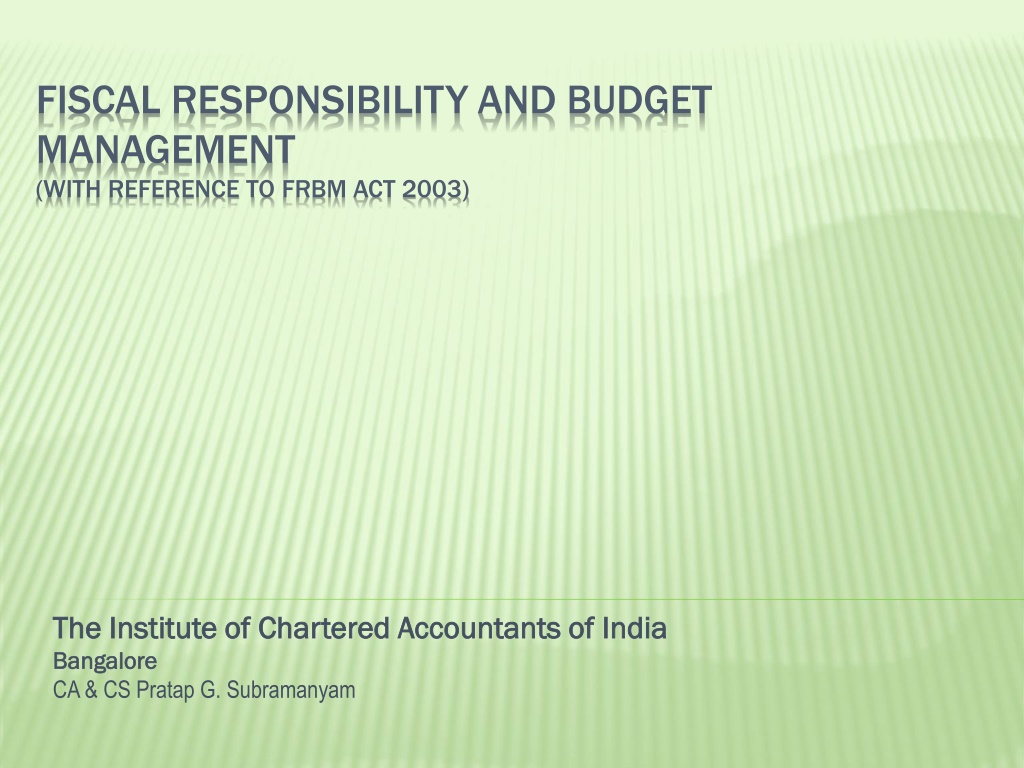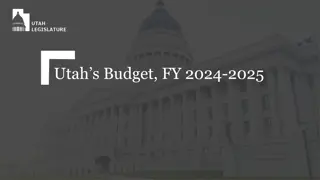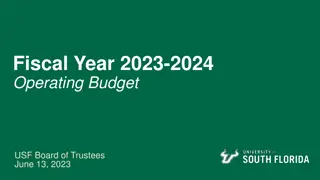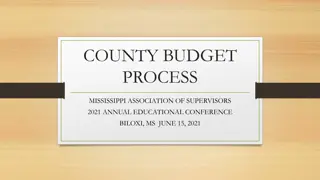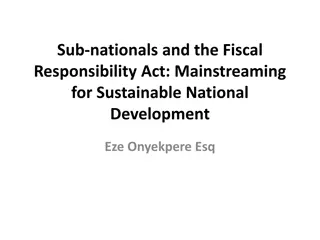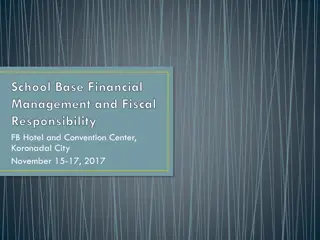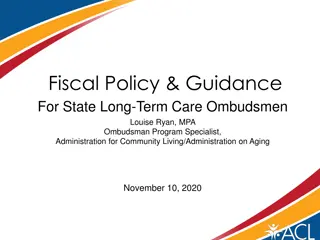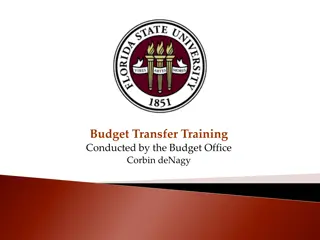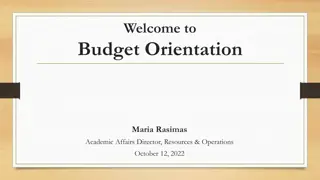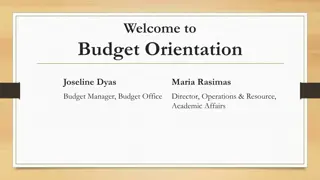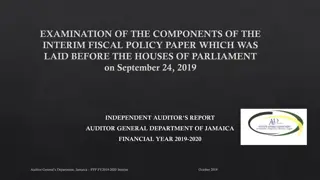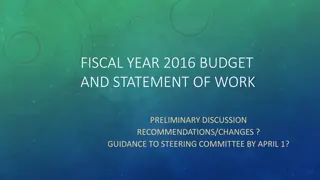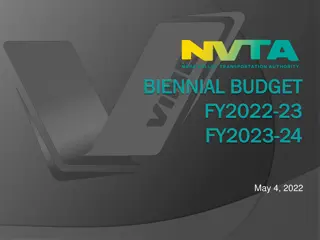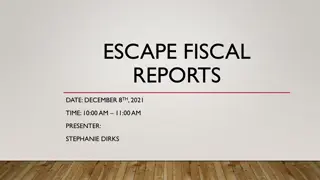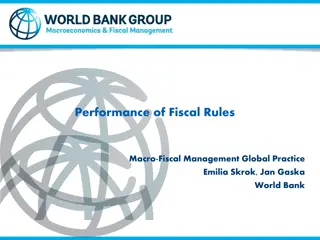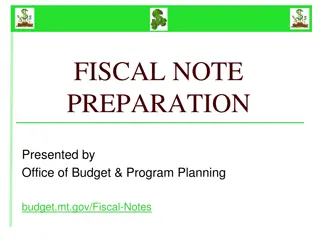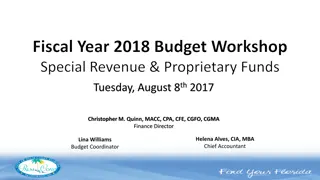Fiscal Responsibility and Budget Management under FRBM Act 2003
The introduction of the FRBM Act in India aligns fiscal and budgetary management practices with global standards. Prior to this, deficits were financed through monetization, but the Act mandates market borrowings. The Act also extends similar guidelines to state governments, aiming for responsible fiscal policies.
Download Presentation

Please find below an Image/Link to download the presentation.
The content on the website is provided AS IS for your information and personal use only. It may not be sold, licensed, or shared on other websites without obtaining consent from the author. Download presentation by click this link. If you encounter any issues during the download, it is possible that the publisher has removed the file from their server.
E N D
Presentation Transcript
FISCAL RESPONSIBILITY AND BUDGET MANAGEMENT (WITH REFERENCE TO FRBM ACT 2003) The Institute of Chartered Accountants of India The Institute of Chartered Accountants of India Bangalore Bangalore CA & CS Pratap G. Subramanyam
BACKGROUND FRBM is a new dispensation in India s fiscal and budgetary management system in line with global practices in this area (US, UK, Eurozone). The dismantling of the Bretton Woods system by the US under Richard Nixon post the oil crisis in 1973 and subsequent adoption of the Gramm Rudman Hollings Balanced Budget Act led to the present budgetary system. The US government presently has authority within the constitution to prepare budgets wherein the deficits are met by borrowings from market. The cumulative debt is capped by legislation. 2
BACKGROUND In Europe, the Maastritch Treaty was signed to form the Euro Zone. Under this Treaty, the respective governments have to finance their respective budgetary deficits through market borrowings. The fundamental principle under this system is that the Central Bank of the country will not monetise budgetary deficits automatically. Governments have to fund budgetary deficits through market borrowings. The Central bank can only conduct open market operations as part of its monetary management function. This is the precise problem for countries like Greece, Spain and Portugal. 3
BACKGROUND In India, prior to the FRBM Act, central government deficits were financed through monetisation of deficits by the RBI (a process known as Deficit Financing ). The state governments have no such facility and their deficits had to be met through borrowings from the central government. The FRBM Act envisaged complete phase out of monetisation of deficits by RBI from 2006. Central government budgetary deficits were to be met through market borrowings. State governments could borrow from market as well. FRBM equivalents were proposed for state governments. 4
MONETARY AND FISCAL POLICY FUNCTIONS FISCAL POLICY FISCAL POLICY The policy associated with management of Government spending based on tax and non-tax revenues. Involves policy with regard to taxation (both direct and indirect) Involves policy with regard to plan and non-plan expenditures. The key policy parameter is about running the twin budget deficits. The key parameter monitored is GDP growth and employment. MONETARY POLICY MONETARY POLICY Involves management of supply of money based on demand parameters and economic performance. Central Banking uses both quantitative tools as well as monetary rate adjustments to control supply of money. Quantitative policy involves increasing or decreasing central bank money through OMO (RBI does this through a window called LAF), Reserve adjustments and QE. Rate adjustments involve calibrating the Repo and Reverse Repo rates. The key parameters monitored are inflation and GDP. 5
REQUIREMENT FOR FRBM ACT The objectives of the Act as stated in the Statement of Objects and Reasons were mainly (a) to curb excessive deficits and bring in fiscal discipline and (b) improve the financial health of the government. The Act came into force from July 5, 2004 after the Ministry of Finance issued the notification for the Act and the FRBM Rules 2004 to come into force. The Act proposed to introduce transparent fiscal management system in the country. to introduce a more equitable and manageable distribution of the country's debts over the years. to aim for fiscal stability for India in the long run. 6
MAIN PROVISIONS OF FRBM ACT The Act provides for Phasing out Revenue Deficit from March 2008 (watered down from 2006) by setting annual targets for reduction. Reduction of annual fiscal deficit. Annual targets for assuming contingent liabilities in the form of guarantees and the total liabilities as a percentage of the GDP. Central Government not to borrow from RBI (section 5) except under exceptional circumstances where there is temporary shortage of cash in particular financial year. Exceptions include national security, natural calamity or other exceptional grounds that the Central Government may specify. Post-facto approval from Parliament to be obtained. 7
MAIN PROVISIONS OF FRBM ACT The Act provides for (under section 3) the government to table on an annual basis the following documents in the Parliament Medium-term Fiscal Policy Statement - a three-year rolling target for the fiscal indicators. This statement should also provide guidance on the status of revenue deficit and whether the government s capital receipts would be usable for productive investment. Four specific disclosures are - revenue deficit , fiscal deficit, tax revenue and total outstanding liabilities (all expressed as a percentage of GDP. Fiscal Policy Strategy Statement An annual statement detailing the priorities for the ensuing financial year in taxation policy and fiscal discipline within the objectives of the Act. Macro Economic Framework Statement An annual Projection of economic indicators such as GDP growth, revenue budget balance, gross fiscal deficit, subsidies, administered pricing and external account balance (balance of payments). 8
MAIN PROVISIONS OF FRBM ACT The targets provided in the Act for various economic and budgetary parameters (section 4 read with FRBM Rules 2004) Annual targets for reduction of revenue deficit. Revenue deficit was to be eliminated by March 2009. Minimum reduction in revenue deficit is 0.5% of GDP. Fiscal deficit to be brought down to 3% of GDP by 2008. Minimum annual reduction 0.3% of GDP. Max new debt obligations and guarantees to be capped at 9% of GDP with progressive reduction of 1% every year to reach 6%. Annual target of not more than 0.5% of GDP for assuming contingent liabilities in the form of guarantees. 9
WEAKNESSES IN THE ACT The central government formulates the rules for itself under delegated legislation. Exceptional circumstances under which the working of the Act can be suspended are defined by the central government. The actions of the central government under the Act are not subject to the jurisdiction of civil courts. The central government or any of its officers cannot be prosecuted for actions performed under the Act. No penal provisions for non-compliance. The Finance Minister to only conduct quarterly reviews of the receipts and expenditures of the Government and place these reports before the Parliament. Deviations to targets set by the Central government for fiscal policy have to be approved by the Parliament. No other measures for failure of compliance have been specified. 10
WORKING OF THE ACT The central government started off well by reducing the revenue deficit to 1.1% and fiscal deficit to 2.7% of GDP. These measures were suspended in the aftermath of the global financial crisis in 2008. The fiscal deficit rose to 6.2% in 2008-09, 4.9% in 2010- 11, 5.9% in 2011-12 and is pegged at 5.1% for the current year (a highly questionable target). Revenue deficit was 4.4% for last FY and is pegged at 3.4% for current year. Indian government s total debt (measured by debt-GDP% ratio) fell under the Act from 75.8% in 2007 to 66.2% in 2011. However it is still among the highest in the world. (Malaysia's 55.1, Pakistan's 54.1, the Philippines' 47, Thailand's 43.7, Indonesia's 25.4 and China's 16.5). The target for 2011-12 is 45.5% according to the Budget. A major portion comprises domestic debt owed to Indian banks, insurance companies and the EPFO which could cause domestic systemic crisis with no immediate external impact on the `. External debt is about 15% of GDP out of which commercial borrowings are about 5% of GDP. 11
AMENDMENTS BY FINANCE ACT 2012 Introduction of the concepts of Effective Revenue Deficit and Medium Term Expenditure Framework statement. Effective Revenue Deficit is the difference between revenue deficit and grants for creation of capital assets. The government s justification is that it will help in reducing consumptive component of revenue deficit and create space for increased capital spending. Medium-term Expenditure Framework statement will set forth a three-year rolling target for expenditure indicators. Recommendations of the Expert Committees to streamline and reduce the number of centrally sponsored schemes and to address plan and non-plan classification to be kept in view while implementing Twelfth Plan. Central Plan Scheme Monitoring System to be expanded for better tracking and utilisation of funds. 12
OUTLOOK FOR 2013 AND BEYOND The key to FRBM implementation is the control of government s unproductive expenditure such as fertiliser subsidy, oil pricing policy, free provision of goods and services under various schemes, NREGA and other social spending. The increase in government spending without corresponding investment and increase in supply side in the past two years has led to steady core and headline inflation and fall in GDP growth. Capital formation has remained stagnant around 13% of GDP. This is despite the RBI s attempts to curb inflation with record number of rate increases. Rate cuts can lead to spur in economic growth and reduce fiscal deficit but can accentuate the present inflation problem as well. 13
OUTLOOK FOR 2012 AND BEYOND India s external current account deficit is at record high of 5.4% of GDP with a worsening BOP and pressure on the `. FDI has been steadily falling and FY 2011-12 closed around $ 28 billion, nowhere near the required FDI target of over $ 50 billion per year. India s net International Position is presently $ 272 billion and is steadily declining. India has been financing import deficits with capital inflows. Experts state that the real exchange rate is presently ` 70-75 to a US$. The INR was the worst currency in 2012 in Asia. India s tax revenue is 51% of total budgetary receipts and is pegged at a tax-GDP ratio of 10.6% for FY 2012-13. It is much lower than in developed countries (UK 34%, Germany 37%, USA 24%). There is a case to increase tax base further than to impose new taxes on the same tax payers. Revenue targets could fall short - tax collections have picked up but shortfall in disinvestment receipts anticipated. 14
OUTLOOK FOR 2012 AND BEYOND Under the FRBM, the effective revenue deficit is pegged at 1.8% of GDP for 2012-13 (out of the total of 3.4%). As per the amendments made by the Finance Act 2012, the government shall strive to eliminate effective revenue deficit by 2015 and bring revenue deficit to not more than 2% of GDP. The government had reached 80% of fiscal deficit for 2012- 13 by November. FM promises to contain to revised target of 5.3% but it looks difficult. Medium term challenges to FRBM mainly from reduced growth and tax collections, rising expenditure-GDP ratio, worsening external revenue deficit and persistent inflation. Overall, the outlook for FRBM in the medium term is grim. 15
FRBM FRAMEWORK RECENT THOUGHT PROCESS In Budget 2007, it was proposed by the Finance Minister to have a separate Debt Management Office (DMO) for which the Public Debt Management Agency of India Bill, 2012 was to be tabled in the Parliament. The idea behind separating the DMO from the RBI was to avoid conflict of interest, as the RBI being the monetary policy authority might have a bias towards a lower interest rate regime to reduce the cost of sovereign debt even if it compromised its anti-inflationary stance. The RBI was opposed to the move as it felt that when the budgetary deficits are high, a separate DMO would cause arbitrary debt issuances by the government without the involvement of RBI. With the change of guard at MoF this proposal has been shelved. Under the current framework, RBI is the debt manager of the government under the provisions of the RBI Act. Going forward increased divergence of views on FRBM account expected. Proposal to make RBI completely autonomous by replacing the RBI Act 1934 is also active. The present RBI Act provides for the government as the overarching authority over RBI. 16
THANK YOU CA & CS Pratap G. Subramanyam FCA,ACS pratapgiri@yahoo.com
